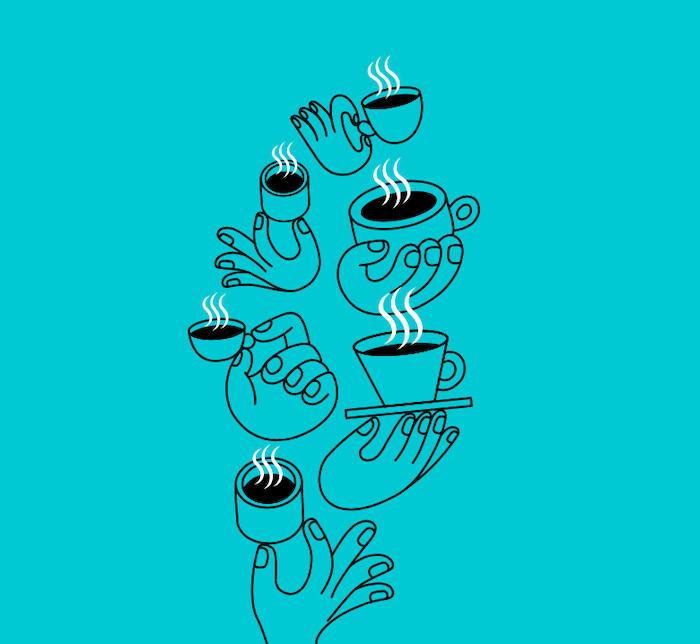
Jake O'Brien Murphy delivers his verdict on the steaming seasonal favourites.
It’s been cold. I don’t mind for two reasons: 1) I have an ample supply of Thinsulate long johns and vests I’m all too eager to get from the back of the cupboard; 2) The news puts together hypercuts of people slipping on ice and, just before you can begin to wonder if that man is seriously injured, another clip fires up and you can laugh again. Here are my thoughts on the seasonal sensation of hot drinks.
The Hot Toddy
Never before has a cocktail been so spiritually close to a sleeveless Argyle sweater. There is something coddling and domestic about the Hot Toddy. It’s like a hug from a knitted nan. Contrary to reason, I kinda like them, but I think that’s an individual deficiency. I’ve let nostalgia and my personal feelings for my paternal grandmother, Helen, win over the strict pragmatic dogmas of deliciousness. All of the literature I have access to points towards the same general notion: etymologically the Hot Toddy is Indian, originally a potable made from palm sap, but was later taken as a pseudo-medicinal drink with scotch and brandy.
Here’s my two cents: I don’t think it’s medicinal at all, the progenitor to modern-day single malt whisky being made around the 18th century was particularly crude, and there’s substantial evidence stretching back to Neolithic times to suggest we’ve always had a penchant for covering up errant flavours in our booze with spice and sweeteners. That is to say, they didn’t consume for the flavour, but the effect. What’s more, a Hot Toddy can only ever aspire to be ‘OK’, or ‘just fine’.
The reason for that is interesting – when you heat any spirit the flavours start to become petulant and begin flying off at different unexpected angles. This is because the way water and ethanol molecules cluster together abruptly changes with increased temperatures. The instinct is to overcorrect with modifying elements, ie sweeteners and acidulants. However, the fact is that when you apply heat aromatic compounds, which are fastidiously selected in distillation, are let loose – and are in danger of being unsightly and unfairly isolated like a testicle in a rugby scrum. This is a recurring issue with hot cocktails.
Mulled Wine
I try to moderate my strong opinions when I write for Class but Mulled Wine and Mulled Cider are universally despicable industrial run-off. Wine doesn’t have the alcoholic strength of spirits and tends, in my experience, to denature and turn flabby quickly after being heated. Some say it concentrates the abundant flavours, similar to how cooking with wine does. That’d be an astute point if I fancied shlamming back a metric litre of bourguignon. Annoyingly, what is extracted in the heating process – subtlety, nuance, tannic structure – is then shoddily replicated with the additives of spices and sweeteners. Again, history provides an unheaded precedent. We can reference the ancient Romans for the practice where they would spice wine to make it palatable – they called it Conditum Paradoxum, or ‘surprise wine’. Marco Gavio Apicio, arguably history's first gastronom, wrote about it, assumedly in between one of the various Republic-wide orgies mandated at the time.
Spiked Hot Chocolate
Yes – it’s the logical culmination of all human sciences. It’s not as simple as it seems. Lower abv is preferable, as it otherwise has a tendency to become coarse. Melted chocolate over powder, to avoid grittiness. Baileys is always an optional addition and a good choice, though it isn’t the engine that drives this drink. I go for a split base of cheap and cheerful whisky and high-quality chocolate liqueurs. The bigger the mug, the better the drink. Then I throw on some knee-high socks and put on a Christmas film about uppermiddle-class people being temporarily miserable and turn it off before they resolve their issues.
Irish Coffee
I am fascinated by the Irish Coffee. As always the history is fraught with inconsistencies and myth – just how we like it. The best I’ve ever tried without pretension but with absolute self-confidence, was at Three Sheets. It’s an indulgence and thoroughly in the spirit of the season. There’s a moment of blissful contrast in the Irish Coffee where chilled cream and warm booze-laced coffee coalesce and the pleasure centres of your brain start to fire at this unprecedented union of fire and ice. It is Azor Ahai reborn. Not only that, but the textural counterpoints of silky cream and spiky booze are truly sublime. In every way, the Irish Coffee is the most structurally effective pousse café ever. It’s all about the push and pull, tug of war, between the mollifying effects of the cream and the edges of the coffee liqueur mix. The only drawback in making Irish Coffees en masse with that much cream is you’re going to end up smelling like a Franciscan cheesemonger. My theory is it works, where other hot drinks don’t, in the fact that it literally bars the expressiveness of the heated booze with a layer of fat.


